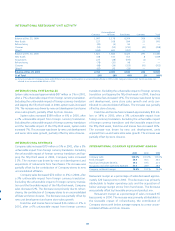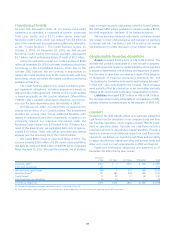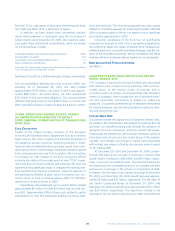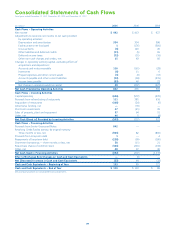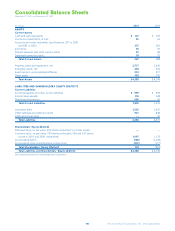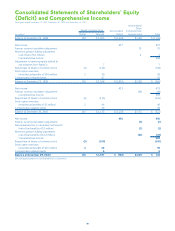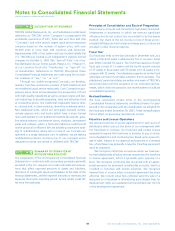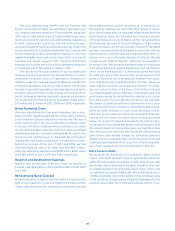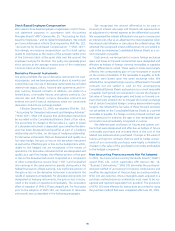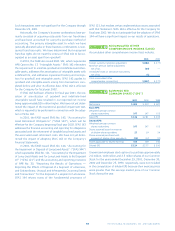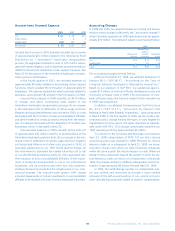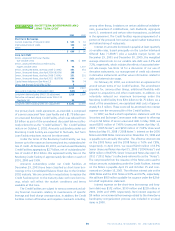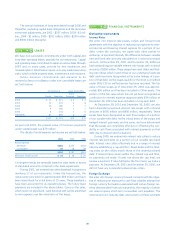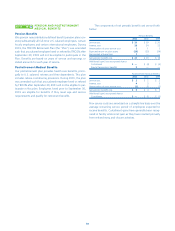Pizza Hut 2001 Annual Report Download - page 45
Download and view the complete annual report
Please find page 45 of the 2001 Pizza Hut annual report below. You can navigate through the pages in the report by either clicking on the pages listed below, or by using the keyword search tool below to find specific information within the annual report.43
We incur expenses that benefit both our franchise and
license communities and their representative organizations and
our company-operated restaurants. These expenses, along with
other costs of sales and servicing of franchise and license agree-
ments are charged to general and administrative expenses as
incurred. Certain direct costs of our franchise and license oper-
ations are charged to franchise and license expenses. These costs
include provisions for estimated uncollectible fees, franchise and
license marketing funding, amortization expense for franchise
related intangible assets and certain other direct incremental
franchise and license support costs. Franchise and license
expenses also includes rent income from subleasing restaurants
to franchisees net of the related occupancy costs.
We monitor the financial condition of our franchisees and
licensees and record provisions for estimated losses on receiv-
ables when we believe that our franchisees or licensees are
unable to make their required payments. While we use the best
information available in making our determination, the ultimate
recovery of recorded receivables is also dependent upon future
economic events and other conditions that may be beyond our
control. Included in franchise and license expenses are provisions
for uncollectible franchise and license receivables of $24 million,
$30 million and $2 million in 2001, 2000 and 1999, respectively.
Direct Marketing Costs
We report substantially all of our direct marketing costs in occu-
pancy and other operating expenses. We charge direct marketing
costs to expense ratably in relation to revenues over the year in
which incurred and, in the case of advertising production costs,
in the year first shown. Deferred direct marketing costs, which
are classified as prepaid expenses, consist of media and related
advertising production costs which will generally be used for the
first time in the next fiscal year. To the extent we participate in
independent advertising cooperatives, we expense our contri-
butions as incurred. At the end of 2001 and 2000, we had
deferred marketing costs of $2 million and $8 million, respec-
tively. Our advertising expenses were $328 million, $325 million
and $385 million in 2001, 2000 and 1999, respectively.
Research and Development Expenses
Research and development expenses, which we expense as
incurred, were $28 million in 2001 and $24 million in both 2000
and 1999.
Refranchising Gains (Losses)
Refranchising gains (losses) includes the gains or losses from the
sales of our restaurants to new and existing franchisees and the
related initial franchise fees, reduced by transaction costs and
direct administrative costs of refranchising. In executing our
refranchising initiatives, we most often offer groups of restau-
rants. We recognize gains on restaurant refranchisings when the
sale transaction closes, the franchisee has a minimum amount
of the purchase price in at-risk equity, and we are satisfied that
the franchisee can meet its financial obligations. If the criteria
for gain recognition are not met, we defer the gain to the extent
we have a remaining financial obligation in connection with the
sales transaction. Deferred gains are recognized when these cri-
teria are met or as our financial obligation is reduced. We only
consider stores “held for disposal” when they are expected to
be sold at a loss. We recognize estimated losses on restaurants
to be refranchised and suspend depreciation and amortization
when: (a) we make a decision to refranchise; (b) the estimated
fair value less costs to sell is less than the carrying amount of the
stores; (c) the stores can be immediately removed from opera-
tions; and (d) the sale is probable within one year. When we
make a decision to retain a store previously held for refranchis-
ing, we revalue the store at the lower of its net book value at
our original disposal decision date less normal depreciation and
amortization during the period held for disposal or its current
fair market value. This value becomes the store’s new cost basis.
We charge (or credit) any difference between the store’s carry-
ing amount and its new cost basis to refranchising gains (losses).
When we make a decision to close a store previously held for
refranchising, we reverse any previously recognized refranchis-
ing loss and then record the store closure costs as described
below. For groups of restaurants expected to be sold at a gain,
we typically do not suspend depreciation and amortization until
the sale is probable. For practical purposes, we treat the closing
date as the point at which the sale is probable. Refranchising
gains (losses) also include charges for estimated exposures
related to those partial guarantees of franchisee loan pools and
contingent lease liabilities which arose from refranchising activ-
ities. These exposures are more fully discussed in Note 22.
Store Closure Costs
We recognize the impairment of a restaurant’s assets as store
closure costs when we have closed or replaced the restaurant
within the same quarter our decision is made. Store closure costs
also include costs of disposing of the assets as well as other facil-
ity-related expenses from previously closed stores. These costs
are expensed as incurred. Additionally, at the date the closure is
considered probable, we record a liability for the net present value
of any remaining operating lease obligations subsequent to the
expected closure date, net of estimated sublease income, if any.


